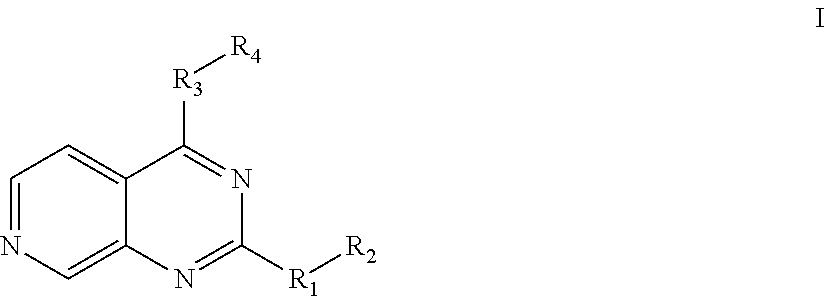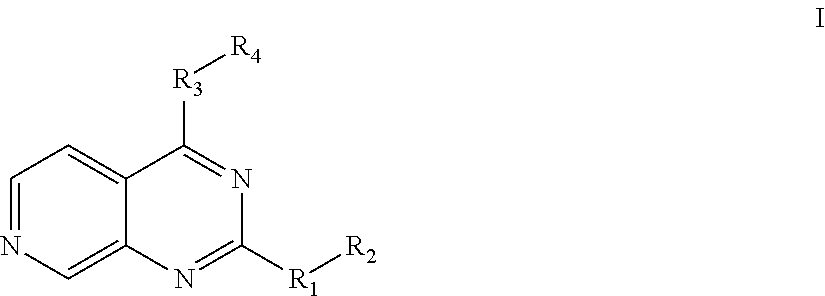7-aza-quinazoline pde10 inhibitors
a technology of azaquinazoline and inhibitors, which is applied in the field of compound compounds, can solve the problems of high non-compliance or discontinuation rate of medication, lack of efficacy, and dissatisfaction with therapy
- Summary
- Abstract
- Description
- Claims
- Application Information
AI Technical Summary
Benefits of technology
Problems solved by technology
Method used
Image
Examples
example 1
[0214]
3-{[(3-Bromophenyl)carbonyl]amino}pyridine-4-carboxylic acid (A-1)
[0215]3-Bromobenzoic acid (16.39 g, 81 mmol), EDC (16.65 g, 87 mmol), HOAT (13.30 g, 87 mmol), and DIEA (20.2 mL, 116 mmol) were dissolved in 500 mL of DMF and stirred at room temperature. After 30 minutes, 3-aminoisonicotinic acid (8 g, 57.9 mmol) was added. After 10 hours, the solvent was removed by rotary evaporation and then triturated with ˜100 mL water. After sonication, the solids were filtered off and dried under vacuum to yield 15.2 g (87%) of A-1 as a tan solid. Data for A-1: LRMS m / z (M+H): 304.64.
3-{[(3-Bromophenyl)carbonyl]amino}pyridine-4-carboxamide (A-2)
[0216]A solution of A-1 (15.2 g, 50.2 mmol) in DMF (350 ml) was treated with EDC (16.7 g, 81 mmol), HOAT (13.3 g, 87 mmol), DIEA (20.2 mL, 116 mmol), and ammonium chloride (17.4 g, 326 mmol). After 8 hours, the solvent was removed by rotary evaporation and the resulting residue was triturated with water. After sonication, the solids were filtered ...
example 2
[0221]
2-Thioxo-2,3-dihydropyrido[3,4-d]pyrimidin-4(1H)-one (B-1)
[0222]To a 1 L round bottom flask containing a stir bar was added 25 g (181 mmol) 3-aminoisonicotinic acid and 68.9 g (905 mmol) thiourea. The solid mixture was heated in an oil bath open to air at 200° C. for 3 h before being cooled to 85° C. At this point, 600 mL of water was added and stirring was continued for 30 minutes at this temperature. The mixture was cooled to room temperature and the solids were collected by filtration, washed with additional water and dried to provide 28.9 g (89%) of B-1 as a light brown solid. Data for B-1:1 HNMR (500 MHz, DMSO-d6) δ 12.9 (s, 1H), 12.7 (s, 1H), 8.7 (s, 1H), 8.5 (d, 1H), 7.75 (d, 1H) ppm.
2,4-Dichloropyrido[3,4-d]pyrimidine (B-2)
[0223]To a suspension of B-1 (500 mg, 2.8 mmol) in 6.5 mL (70 mmol) POCl3 was added DMF (32 μL, 0.4 mmol) and the mixture was heated in the microwave at 130° C. for 10 minutes. The reaction was transferred to a 250 mL round bottom flask with the help...
example 3
[0226]
2-[(E)-2-Phenylvinyl]-N-(pyrimidin-5-ylmethyl)pyrido[3,4-d]pyrimidin-4-amine (C-2)
[0227]Nitrogen gas was bubbled through a solution of 50 mg (0.183 mmol) of C-1 (prepared by a procedure similar to that of B-3) in anhydrous DMF in a small microwave vial for several minutes to degas. Styrene (0.032 mL, 0.275 mmol), triethylamine (0.051 mL, 0.367 mmol), tri-o-tolylphosphine (5.6 mg, 0.018 mmol), and palladium acetate (4.1 mg, 0.018 mmol) were added and then heated in the microwave to 150° C. for 10 min., then 180° C. for 5 min. The above amounts of styrene, NEt3, ligand, and catalyst were added and the reaction was again heated again to 160° C. for 10 min. The reaction was partitioned between EtOAc and saturated aqueous NaHCO3 solution and separated. The organic layer was washed with sat. NaHCO3 solution, water, and brine, then dried with Na2SO4 and concentrated. The residue was purified using reverse-phase chromatography (95:5 to 5:95 water-acetonitrile (both with 0.1% TFA) and ...
PUM
 Login to View More
Login to View More Abstract
Description
Claims
Application Information
 Login to View More
Login to View More - R&D
- Intellectual Property
- Life Sciences
- Materials
- Tech Scout
- Unparalleled Data Quality
- Higher Quality Content
- 60% Fewer Hallucinations
Browse by: Latest US Patents, China's latest patents, Technical Efficacy Thesaurus, Application Domain, Technology Topic, Popular Technical Reports.
© 2025 PatSnap. All rights reserved.Legal|Privacy policy|Modern Slavery Act Transparency Statement|Sitemap|About US| Contact US: help@patsnap.com



